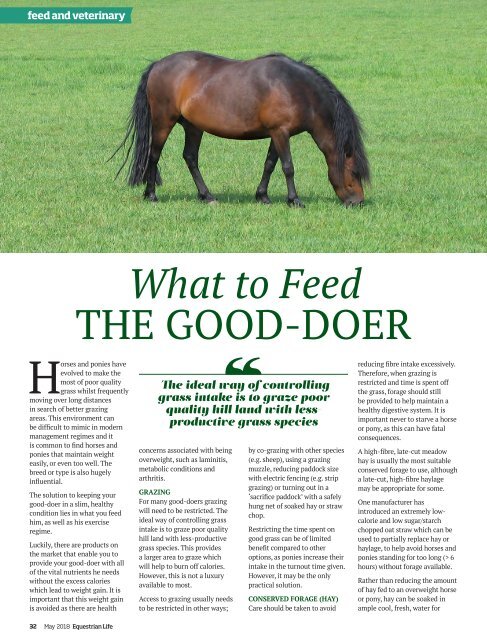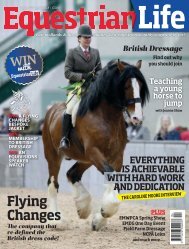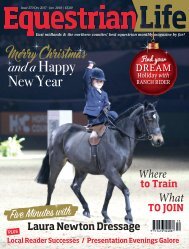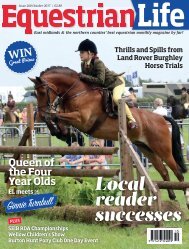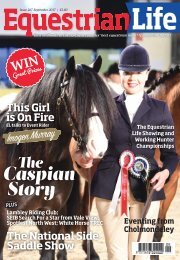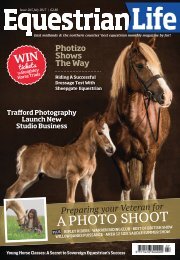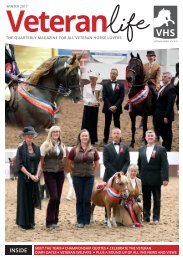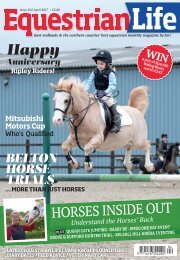Equestrian Life May 2018 Issue
You also want an ePaper? Increase the reach of your titles
YUMPU automatically turns print PDFs into web optimized ePapers that Google loves.
feed and veterinary<br />
What to Feed<br />
THE GOOD-DOER<br />
Horses and ponies have<br />
evolved to make the<br />
most of poor quality<br />
grass whilst frequently<br />
moving over long distances<br />
in search of better grazing<br />
areas. This environment can<br />
be difficult to mimic in modern<br />
management regimes and it<br />
is common to find horses and<br />
ponies that maintain weight<br />
easily, or even too well. The<br />
breed or type is also hugely<br />
influential.<br />
The solution to keeping your<br />
good-doer in a slim, healthy<br />
condition lies in what you feed<br />
him, as well as his exercise<br />
regime.<br />
Luckily, there are products on<br />
the market that enable you to<br />
provide your good-doer with all<br />
of the vital nutrients he needs<br />
without the excess calories<br />
which lead to weight gain. It is<br />
important that this weight gain<br />
is avoided as there are health<br />
The ideal way of controlling<br />
grass intake is to graze poor<br />
quality hill land with lessproductive<br />
grass species<br />
concerns associated with being<br />
overweight, such as laminitis,<br />
metabolic conditions and<br />
arthritis.<br />
GRAZING<br />
For many good-doers grazing<br />
will need to be restricted. The<br />
ideal way of controlling grass<br />
intake is to graze poor quality<br />
hill land with less-productive<br />
grass species. This provides<br />
a larger area to graze which<br />
will help to burn off calories.<br />
However, this is not a luxury<br />
available to most.<br />
Access to grazing usually needs<br />
to be restricted in other ways;<br />
by co-grazing with other species<br />
(e.g. sheep), using a grazing<br />
muzzle, reducing paddock size<br />
with electric fencing (e.g. strip<br />
grazing) or turning out in a<br />
‘sacrifice paddock’ with a safely<br />
hung net of soaked hay or straw<br />
chop.<br />
Restricting the time spent on<br />
good grass can be of limited<br />
benefit compared to other<br />
options, as ponies increase their<br />
intake in the turnout time given.<br />
However, it may be the only<br />
practical solution.<br />
CONSERVED FORAGE (HAY)<br />
Care should be taken to avoid<br />
reducing fibre intake excessively.<br />
Therefore, when grazing is<br />
restricted and time is spent off<br />
the grass, forage should still<br />
be provided to help maintain a<br />
healthy digestive system. It is<br />
important never to starve a horse<br />
or pony, as this can have fatal<br />
consequences.<br />
A high-fibre, late-cut meadow<br />
hay is usually the most suitable<br />
conserved forage to use, although<br />
a late-cut, high-fibre haylage<br />
may be appropriate for some.<br />
One manufacturer has<br />
introduced an extremely lowcalorie<br />
and low sugar/starch<br />
chopped oat straw which can be<br />
used to partially replace hay or<br />
haylage, to help avoid horses and<br />
ponies standing for too long (> 6<br />
hours) without forage available.<br />
Rather than reducing the amount<br />
of hay fed to an overweight horse<br />
or pony, hay can be soaked in<br />
ample cool, fresh, water for<br />
32 <strong>May</strong> <strong>2018</strong> <strong>Equestrian</strong> <strong>Life</strong>


